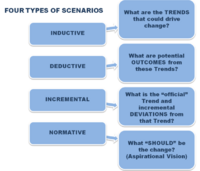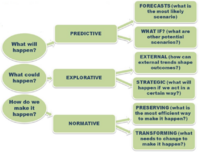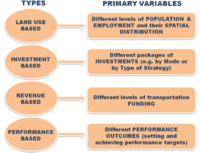Scenario Planning Strategy
(→Scenarios) |
(→Scenarios) |
||
| Line 20: | Line 20: | ||
The categorization of the scenarios, facilitates the communication, comprehension, comparison and further development of the concept <ref name="types">.Lena Bo¨ rjesona, Mattias Ho¨ jera, Karl-Henrik Dreborgb,Tomas Ekvallc, Go¨ ran Finnvedena. ELSEVIER "''Scenario types and techniques: Towards a user’s guide''" (2006)</ref>. Nonetheless, a concensus hasn't been reached yet and a standarization hasn't been attemped. The following diagramms show three common approaches of scenario typologies according to the angle and the variants that each one has been developed. | The categorization of the scenarios, facilitates the communication, comprehension, comparison and further development of the concept <ref name="types">.Lena Bo¨ rjesona, Mattias Ho¨ jera, Karl-Henrik Dreborgb,Tomas Ekvallc, Go¨ ran Finnvedena. ELSEVIER "''Scenario types and techniques: Towards a user’s guide''" (2006)</ref>. Nonetheless, a concensus hasn't been reached yet and a standarization hasn't been attemped. The following diagramms show three common approaches of scenario typologies according to the angle and the variants that each one has been developed. | ||
| − | + | ||
| − | + | ||
| − | + | [[File:shell.png|thumb|right|200px|Figure 1: Four types of scenarios by Ged Davis (Shell Oil, 2002)<ref name="typologies">.VLAD GAVRILOVIC, Renaissance Planning "''TOWARDS A TYPOLOGY OF SCENARIO PLANNING''" Online article http://www.citiesthatwork.com/blog-renaissance/2014/02/towards-a-typology-of-scenario-planning] Retrieved on 21 October 2017</ref> (click to zoom)]] | |
| − | + | [[File:Sweden.png|thumb|right|200px|Figure 2: Three types of scenarios by Royal Institute of Technology, Sweden (2005)<ref name="typologies"></ref> (click to zoom)]] | |
| − | + | [[File:map-21.png|thumb|right|200px|Figure 3: Types of scenarios by Federal Highway Administration (FHWA), MAP-21 Guidance (2012)<ref name="typologies"></ref> (click to zoom)]] | |
| + | |||
Several approaches have been developed in a theoritical point of view pertaining the creation of scenarios. In practise, each organization choose their own strategy and key principles for a good scenario formation. A general guidance for a succesful scenario creation is summarized below (PMI project portfolio): | Several approaches have been developed in a theoritical point of view pertaining the creation of scenarios. In practise, each organization choose their own strategy and key principles for a good scenario formation. A general guidance for a succesful scenario creation is summarized below (PMI project portfolio): | ||
#The plausibility of scenarios and the rational consistancy with the known facts is the first key principle. Apart from being interesting they should be also challenging in respect to organizatios' criteria. It worth to note that even if a wide range of possible scenarios will be determined for a particular issue, as a group should be mutual exclusive and concise. | #The plausibility of scenarios and the rational consistancy with the known facts is the first key principle. Apart from being interesting they should be also challenging in respect to organizatios' criteria. It worth to note that even if a wide range of possible scenarios will be determined for a particular issue, as a group should be mutual exclusive and concise. | ||
| + | #During the implementation of scenario planning process, organizations should have the consciousness and insight comprehension that divergence and not convergence drives the industries. Their envisage of the future should crearly shows that. | ||
===Project Program and Portfolio Managemnet=== | ===Project Program and Portfolio Managemnet=== | ||
Revision as of 10:44, 22 September 2017
Scenario Planning Strategy is a systematic and methodical way for organisations to define their future actions. It is considered as part of the Strategic management tools, aiming to create a flexible plan, based on which the organisation will benefit in the long term. Scenario planning came to change and enchance the way of thinking in terms of decision making under critical uncertain cirumstancies. According to Pierre Wack "Scenarios deal with two worlds; the world of facts and the world of perceptions" [1]. The known and the unknown are mixed and a set of different possible scenarios for a particular issue is formed following people's both subjective and objective thoughts regarding how the social, technical, economic, environmental and political (STEEP) trends are going to affect it. The holistic integrated pictures of the future assist companies to both quantify and qualify their future policies and strategies creating an adaptable planning that mitigates the possible negative impacts on them.
Different types of scenarios exists such as ‘mission scenarios’, ‘issues scenarios’,‘action scenarios' [2] 'crisis scenarios' etc depending on the specific case. There are also different approaches and steps for utilizing scennario planning in buisnesses. Nowadays, a common thread to identify your possible scenarios is to implement a SWOT analysis or PEST Analysis having in mind the pace of which changes happen in the buisness sector, increasing buisness critical uncertainties. Although, as in every management tool there are sthernths and weaknesses that managers and buisnesses should take into account and will be analyzed in the article as well. A specific focus will be made in scenario planning and its liason with project porgramm and portfolio management. The article aims to investigate in what extend this tool can be implemented and what it the process to succeed it. A general overview of scenarios development and the Progect program and Portfolio Management context will be presented in order to identify their incorporation.
Contents |
Big Idea
Origin of Scenarios
The first time that scenario planning came into view as a concept was during the Second World War as a technique for military planning, trying to conceive and prepare against, the opponents' actions [2]. The years after, the concept further developed in militarry intelligence focusing on policy games where different parties invlonved, were playing different roles under multiple plausible stories, with the view to observe the reaction of persons under different uncertain circumstancies. Later, during 1970s, scenario planning revolutionize buisness sector with its application in Royal Duch Shell. Pierre Wack, was the first who was looking for possible strategies in case an unexpected event occured in the Oil market. Through his scenarios, he facilitated the managers of the company to imagine their decision in case each of this scenarios was taken place [2]. When the oil crises broke out in 1973 no one was expecting it and only Shell was effectively prepared to address the issue. A widerspread acceptance and an increase in the tools appeal was firther reinforced after teh the terorist attach in September 11th 2001 in the US (economist). The attack was one of the most tangible examples of the hight uncertenties that occur in 21st century along with its tremendous impacts.
Context
Scenarios
Scennario planning it is not about predicting the most likely future; it is about addressing assorted sets of strategic buisness issues by rehearsing different decisions based on a range of possibilities [3]. Different kind of scenarios exist that is hard to sort them. The categorization of the scenarios, facilitates the communication, comprehension, comparison and further development of the concept [4]. Nonetheless, a concensus hasn't been reached yet and a standarization hasn't been attemped. The following diagramms show three common approaches of scenario typologies according to the angle and the variants that each one has been developed.



Several approaches have been developed in a theoritical point of view pertaining the creation of scenarios. In practise, each organization choose their own strategy and key principles for a good scenario formation. A general guidance for a succesful scenario creation is summarized below (PMI project portfolio):
- The plausibility of scenarios and the rational consistancy with the known facts is the first key principle. Apart from being interesting they should be also challenging in respect to organizatios' criteria. It worth to note that even if a wide range of possible scenarios will be determined for a particular issue, as a group should be mutual exclusive and concise.
- During the implementation of scenario planning process, organizations should have the consciousness and insight comprehension that divergence and not convergence drives the industries. Their envisage of the future should crearly shows that.
Project Program and Portfolio Managemnet
In a project programm and porfolio percpective
Application
When scenario planning is applicable
Keeping up with the rapid evolution of technology, the political and social changes and the general unstable buisness environmnet, enables scenario planning an inseparable tool in strategic managememt. Potentials has also been identified in its application in Project Program and Portfolio management. More specifically, it significanlty improves the way that a wide range of buisness problems are addressed in terms of organization [3].The application of scenario planning is not restricted in specific cases. Although, it is hard to define the exact circumstancies under which the tool should be used, the following broaden conditions can be identified:[6] [3]:
- Creation of a more sustainable long-term strategy
- Decision making under uncertain conditions
- Targeting on innovation reinforcement
- Aligning key stakeholders in support of a shared vision
- Large deviation of opinions regarding decision
- The indusrty has already affected by an importand change or is expected to
- Low quality of strategic thinking
The tool can also find its application as a share knowledge and networking process, utilizing the collective participation from people with different backround with the view not only to challenge strategic paradigms but also to redefine the borders of the organization [add ref networking].
How to use the tools
As it has already mentioned, scenario planning is a strategy that consists of multiple plausible scenarios considering a wide spectrum of posibilities, in order to develop robust strategies. The question is how to start using this process in order to fully exploit its opportunities. The engagement of high level executives is required along with experts, researchers and managers. Divercity of knowledge is a neccessity in order to examine scenarios in multiple dimensios. Several approaches have been developed standarizing the steps of the implementation process.
Project Program and Porfolio Management
Example
Limitations
References
- ↑ .The Economist, "Scenario planning". Online article [URL: http://www.economist.com/node/12000755] Retrieved on 15 October 2017
- ↑ 2.0 2.1 2.2 . Dana Mietzner & Guido Reger"Advantages and disadvantages of scenarioapproaches for strategic foresight",Department of Economics and Social Sciences, University of Potsdam" (2005). [1]
- ↑ 3.0 3.1 3.2 .GBN Global Buisness Network, Monitor Group "Introduction to Scenario planning" (2008)
- ↑ .Lena Bo¨ rjesona, Mattias Ho¨ jera, Karl-Henrik Dreborgb,Tomas Ekvallc, Go¨ ran Finnvedena. ELSEVIER "Scenario types and techniques: Towards a user’s guide" (2006)
- ↑ 5.0 5.1 5.2 .VLAD GAVRILOVIC, Renaissance Planning "TOWARDS A TYPOLOGY OF SCENARIO PLANNING" Online article http://www.citiesthatwork.com/blog-renaissance/2014/02/towards-a-typology-of-scenario-planning] Retrieved on 21 October 2017
- ↑ Paul J. H. Schoemaker "When and hoe to use scenario planning: a heuristic approach with illustrations" (1991)
Annotated bibliography
- 1. Winch, G. M. (2010), "Managing Construction projects". Second edition
- Summary: